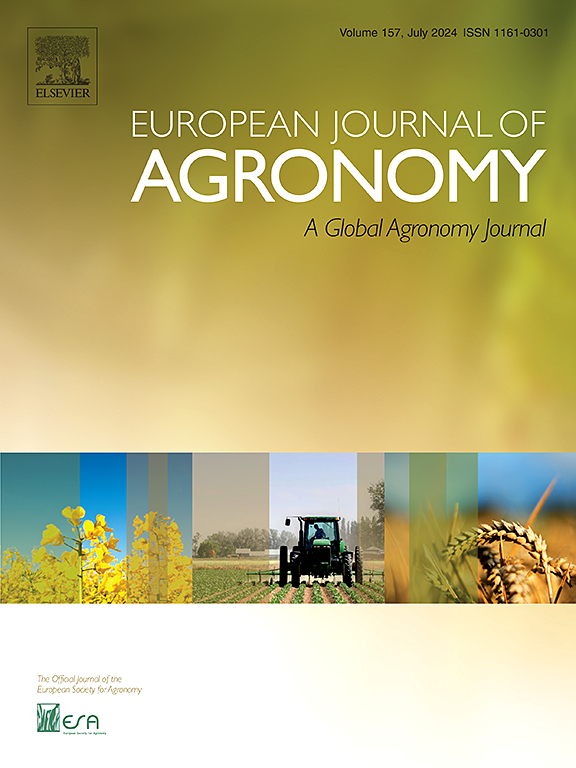Assessing climate change impacts and adaptation strategies for key crops in the Republic of Moldova using the AquaCrop model
IF 4.5
1区 农林科学
Q1 AGRONOMY
引用次数: 0
Abstract
Impact-based models are an essential tool to better understand the effects of climate change on crop production and to aid in the adaptation planning processes. However, in the Republic of Moldova (RoM), there is limited integration of crop simulation findings into adaptation policies and plans (see National Adaptation Plan (NAP) adopted in 2024). To bring novelty to this topic, the Food and Agriculture Organization (FAO), in conjunction with the State Hydrometeorological Service and the State Commission for Plant Variety Testing of the RoM, aims to assess the effect of future climate on five crops of national importance (maize, tomatoes, sunflowers, green peas, and wheat). We use state-of-the-art climate (Coordinated Regional Downscaling Experiment (CORDEX) and Coordinated Output for Regional Evaluations (CORE)) and crop models (AquaCrop) for two climate change scenarios: Representative Concentration Pathways (RCPs) 2.6 and 8.5. Adaptation solutions across the RoM are explored by advancing or delaying the sowing dates and enhancing field management decisions by improving soil fertility and reducing weed stress. Statistically significant (p < 0.05) higher yields are simulated when advancing the sowing date of maize and when growing medium cycle varieties as opposed to short cycle. A CO2-enriched environment (RCP 8.5) leads to statistically significantly higher yields among C3 crops (wheat and green peas) but has detrimental effects on C4 crops (maize). Limiting climatic drivers include decreasing seasonal rainfall, a higher number of dry days and heat-stress conditions during the summertime, and, conversely, fewer cold days during the wintertime necessary for wheat vernalization. As a result, this research not only provides valuable insights for stakeholders mandated to provide evidence-based adaptation, such as the National Commission on Climate Change, but also uncovers potential adaptation solutions to mitigate the adverse effects of climate change.
利用AquaCrop模型评估摩尔多瓦共和国主要作物的气候变化影响和适应战略
基于影响的模型是更好地了解气候变化对作物生产的影响和协助适应规划进程的重要工具。然而,在摩尔多瓦共和国(RoM),将作物模拟结果有限地纳入适应政策和计划(见2024年通过的国家适应计划(NAP))。为了给这一主题增添新意,粮农组织与国家水文气象局和国家植物品种试验委员会合作,旨在评估未来气候对五种重要的国家作物(玉米、西红柿、向日葵、青豆和小麦)的影响。我们使用最先进的气候(协调区域降尺度实验(CORDEX)和区域评估协调产出(CORE))和作物模型(AquaCrop)来模拟两种气候变化情景:代表性浓度路径(rcp) 2.6和8.5。通过提前或推迟播种日期,以及通过提高土壤肥力和减少杂草胁迫来加强田间管理决策,探索了整个区域的适应解决方案。提前玉米播种日期和种植中周期品种比短周期品种的产量有统计学意义(p <; 0.05)。富含二氧化碳的环境(RCP 8.5)导致C3作物(小麦和青豆)的产量显著提高,但对C4作物(玉米)产生不利影响。限制气候驱动因素包括季节性降雨减少,夏季干燥天数和热胁迫条件增加,相反,冬季小麦春化所需的寒冷天数减少。因此,本研究不仅为国家气候变化委员会等负责提供循证适应的利益相关者提供了有价值的见解,而且还揭示了缓解气候变化不利影响的潜在适应解决方案。
本文章由计算机程序翻译,如有差异,请以英文原文为准。
求助全文
约1分钟内获得全文
求助全文
来源期刊

European Journal of Agronomy
农林科学-农艺学
CiteScore
8.30
自引率
7.70%
发文量
187
审稿时长
4.5 months
期刊介绍:
The European Journal of Agronomy, the official journal of the European Society for Agronomy, publishes original research papers reporting experimental and theoretical contributions to field-based agronomy and crop science. The journal will consider research at the field level for agricultural, horticultural and tree crops, that uses comprehensive and explanatory approaches. The EJA covers the following topics:
crop physiology
crop production and management including irrigation, fertilization and soil management
agroclimatology and modelling
plant-soil relationships
crop quality and post-harvest physiology
farming and cropping systems
agroecosystems and the environment
crop-weed interactions and management
organic farming
horticultural crops
papers from the European Society for Agronomy bi-annual meetings
In determining the suitability of submitted articles for publication, particular scrutiny is placed on the degree of novelty and significance of the research and the extent to which it adds to existing knowledge in agronomy.
 求助内容:
求助内容: 应助结果提醒方式:
应助结果提醒方式:


